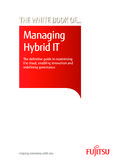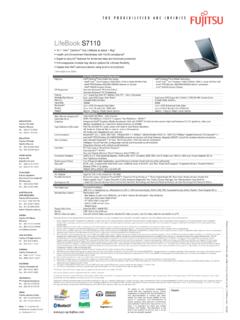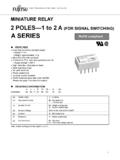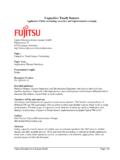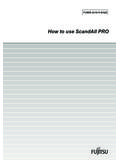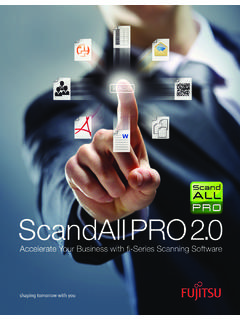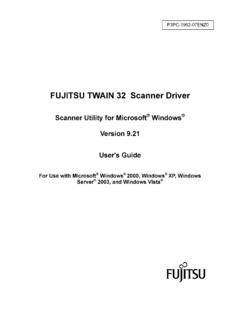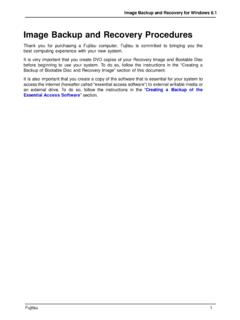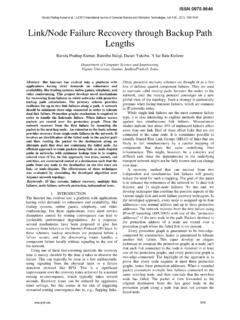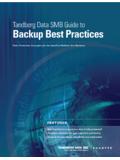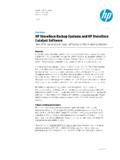Transcription of Image ackup and Recovery Procedures For Windows 7
1 Image Backup and Recovery Procedures For Windows 7 Thank you for purchasing a fujitsu computer. fujitsu is committed to bringing you the best computing experience with your new system. It is very important that you create DVD copies of your Recovery Image and Bootable Disc before beginning to use your system. To do so, follow the instructions in the Creating a Backup of Bootable Disc and Recovery Image section of this document. It is also important that you create a copy of the software that is essential for your system to access the internet (hereafter called essential access software ) to external writable media or an external drive. To do so, follow the instructions in the Creating a Backup of the System-Specific Software Drivers section. MAKING BACKUPS OF THE Recovery Image AND SOFTWARE Creating a Backup of Bootable Disc and Recovery Image When you purchased your new system, a copy of the Recovery Image was loaded into a hidden partition on your hard disk drive.
2 Having a copy of the Recovery Image available to you means that in the event of system failure, you will be able to restore it. To make a copy of the Recovery Image to DVD discs, you will need three or four blank discs to create the copy. Please take note that you are allowed to create the Recovery Image DVD for one time ONLY. After creating the copy, be sure to label the discs and keep them in a safe place to ensure they do not get damaged. Note: If your system does not have an internal writable DVD drive, connect your system to an external drive* before beginning the following steps. * DEPENDING UPON YOUR OPTICAL DRIVE AND MEDIA FORMAT USED, SOME MEDIA TYPES MAY BE INCOMPATIBLE FOR CREATING Image BACKUPS. 1. Launch System Restore and Recovery from the desktop icon. It will allow you to create the Bootable Disc and the Recovery Image Disc Set. 2. In Step 1: Please select a media type for Recovery Disc.
3 : a. Select Bootable Disc to create the Bootable Disc. b. Select a recordable drive and a media type. c. Take note of the number of discs required for the set. d. Click Next to proceed. 3. In Step 2: Confirm your Recovery Disc , click Next. 4. In Step 3 , follow the on-screen instructions to make the disc or disc set, then click Start. It takes approximately 30 minutes to make one disc. 5. In Step 4 , when disc creation is completed, a message appears. Click Finish to exit the program. 6. Repeat all the above steps where in Step 2(a) select Recovery Disc from the list to create the Recovery Image Disc Set. Creating a Backup of the System-Specific Software Drivers We recommend that you create a backup of the content of the "C:\Drivers" on your system to writable media or an external drive. System-Specific Software Drivers are also available for download through the fujitsu Support Site.
4 Note: For some earlier operating system images, the System-Specific Software Drivers are not in C:\Drivers . You can further determine that your OS is one of these by verifying that a file 2016 Update is NOT located in C:\ fujitsu \Model . In this case, follow the steps below to get and save the software. 1. Open the C:\ fujitsu \Drivers\AutoInstaller\ folder 2. Run fujitsu Software Extractor as an Administrator a. Right-click on fujitsu Software Extractor. b. Select the Run as Administrator option from the popup menu that is displayed. 3. The default save location is C:\ fujitsu \AutoInstaller\Drivers\. You can change the location by clicking on the Browse button and selecting your preferred location. Note: It is recommended that you change the default location and save the software packages to the external writable media or drive. 4. Click on the Save Packages button. 5. fujitsu Software Extractor copies the zipped software packages and Readme files, and extracts the Auto Installer folder to the selected location.
5 Note: The extracted Auto Installer will later be used to install the software automatically on the system, in the event the system is recovered with the generic Image where the software is not pre-installed in the Image . RECOVER YOUR SYSTEM WHEN THE HARD DRIVE IS STILL ACCESSIBLE Using the Recovery and Utility Tools The Recovery and Utility tools consist of a variety of tools that will help you recover your Recovery Image and system images, and delete the data from your hard disk. Methods for Accessing the Utilities Recovery and Utility Tools are preinstalled in a hidden partition by the factory, or they can be accessed by using the bootable disc. Note: The Recovery and Utility tools may be deleted from your hard disk drive if you modify the partitions. If that occurs, you will not be able to use the hidden partition for booting to Recovery and Utility Tools, but you will still be able to boot from the Bootable Disc.
6 Determining whether Recovery and Utility is Pre-loaded 1. Turn on or reboot your system. When the fujitsu logo appears, press the F12 key. (*Actual screen display varies between models.) 2. Use the Tab key to access the Application Menu. (*Actual screen display varies between models.) 3. Check whether the Recovery and Utility option is present. If it is not present, it means that the utility must be used from the Bootable Disc. Proceed to Running Recovery and Utility from the Bootable Disc if Recovery and Utility is unavailable. (*Actual screen display varies between models.) ---Boot Menu Application Menu--------- 1. Drive0 HDD: 2. CD/DVD Drive: 3. NETWORK: -------------------------------------- ---Boot Menu Application Menu--------- 1. BIOS Setup 2. Diagnostic Screen 3. Recovery and Utility 4. Diagnostic Program -------------------------------------- ---Boot Menu Application Menu--------- 1. BIOS Setup 2.
7 Diagnostic Screen 3. Recovery and Utility 4. Diagnostic Program -------------------------------------- Running Recovery and Utility from Hard Disk 1. Turn on or reboot your system. When the fujitsu logo appears, press the F12 key. (*Actual screen display varies between models.) 2. Use the Tab key to get to the Application Menu. (*Actual screen display varies between models.) 3. Move the cursor down to Recovery and Utility and press the Enter key. (*Actual screen display varies between models.) 4. The Recovery environment initializes, then the System Recovery Options appears. Select a keyboard input method and click Next. ---Boot Menu Application Menu--------- 1. Drive0 HDD: 2. CD/DVD Drive: 3. NETWORK: -------------------------------------- ---Boot Menu Application Menu--------- 1. BIOS Setup 2. Diagnostic Screen 3. Recovery and Utility 4. Diagnostic Program -------------------------------------- ---Boot Menu Application Menu--------- 1.
8 BIOS Setup 2. Diagnostic Screen 3. Recovery and Utility 4. Diagnostic Program -------------------------------------- 5. Select an operating system to recover, then click Next. 6. Select user name and enter the password, click OK. 7. Click Recovery and Utility. 8. The Recovery and Utility options will be shown. 9. If this was successful, please skip the next step and go to the section Recovery and Utility Tools . 10. If this was NOT successful, please go to the next section. Running Recovery and Utility from the Bootable Disc Note: If your system does not have an internal writable DVD drive, connect your system to an external drive. To verify/change the boot-up priority (rather than booting-up from the hard drive or an external media drive), perform the following steps: 1. Turn on or reboot your system. When the fujitsu logo appears on the screen, press the F12 key.
9 (*Actual screen display varies between models.) 2. Insert the bootable disc into the drive tray. 3. Highlight the CD/DVD option from the Boot Menu, then press Enter. (*Actual screen display varies between models.) 4. While the files are being loaded from the disc, a progress bar is displayed at the bottom of the screen. 5. The Recovery environment initializes, and then the Recovery and Utility options appears. Recovery and Utility Tools Select the Recovery tab to display the Recovery tool. It contains two options: Restoring the Factory Image (only C: drive) Restoring the Factory Image (full hard drive Recovery ) ---Boot Menu Application Menu--------- 1. Drive0 HDD: 2. CD/DVD Drive: 3. NETWORK: -------------------------------------- ---Boot Menu Application Menu--------- 1. Drive0 HDD: 2. CD/DVD Drive: 3. NETWORK: -------------------------------------- You can use these tools to restore the Recovery Image from the hidden partition, and perform a full hard drive Recovery .
10 Please refer to instructions in the Creating a Backup of Bootable Disc and Recovery Image section for details on how to create a Recovery Image disc set. Restore the Recovery Image from Hidden Partition 1. Select Restoring the Factory Image (only C: drive) from Recovery tool, and click Execute. 2. Read the instructions for use carefully, then select I agree and Next to proceed if you accept the license terms; or select I disagree to leave the Recovery environment. 3. All data on the C: drive will be deleted. Click OK to start the Recovery process. 4. The progress bar appears. Wait for the process to complete. 5. When the Recovery process completes, the message Restoration has been completed. Click [OK] to reboot the computer will be shown. Click OK to restart to Windows . 6. For some earlier operating system images, the OS may not come with complete Drivers/Applications installed.


